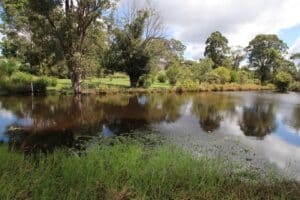One of the most important global meetings on wildlife trade has just wrapped up in Uzbekistan. It’s capital city Samarkand was where governments convened for the 20th Conference of the Parties (CoP20) to the Convention on International Trade in Endangered Species of Wild Fauna and Flora (CITES) to decide how international trade should be managed for some of the world’s most threatened...


Left: Waterways of the property support diverse waterbirds and invertebrates.
Right: Superb collared frog (Cyclorana brevipes).
Photo credits: Scott and Susan Reilly
Babbler Cottage
Queensland • SOUTH BURNETT
Babbler Cottage is a tiny 0.9 hectare bush block in Wakka Wakka country, walking distance to the town of Yarraman. Grey-crowned babblers both live and breed on this property.
The Box/Ironbark grassy woodlands were cleared in the 1950s, including all hollow bearing eucalypts, for marginal grazing. The original farm was subdivided into small blocks in the 1980s.
Unfortunately, the most recent previous owner had done absolutely nothing to either the land or the house. In 2018 we purchased a derelict home in a weed and European rabbit infested ‘eyesore’. Fifty-four cubic metres of rubbish and four body trucks of weeds were removed.
We began with fencing the perimeter with galvanised star pickets and plain wire, to protect our resident, red-necked wallabies, gliders, flying-foxes, blossom bats, microbats and birds. Close encounters with barbwire can and do harm and kill. Scott constructed and installed 12 nest/roost boxes to house our hollow-dependent wildlife. Hollows are just developing in our Eucalyptus moluccana and Corymbia citriodora sub.sp. variegate. Unfortunately, remaining old eucalypts continue to be felled for horse paddocks.
We tag our locally native vegetation and chip, ‘chop and drop’ all weeds and then replant. We construct refuges from dead fall timber to provide safe hiding places for our small birds, reptiles, amphibians and invertebrates. Clearing weeds provides a killing field for our avian predators. No vegetation leaves the property, adding biomass to degraded soil, and slowing overland water flow. We leave large flat rocks in the grasslands to provide warm, safe habitat for our legless lizards. Floristic complexity is enhanced by the resident satin and regent bowerbirds depositing seed from the neighbouring Dry Vine Scrub and Dry Rain Forest. Our dam is a valuable fringing and aquatic habitat.
We founded and have managed ‘The Friends of the Yarraman Creek Inc.’ since 2012. A community volunteer riparian restoration project on the Yarraman Creek www.facebook.com/yarramancreek4614. This is our second tiny Wildlife Land Trust property in Yarraman, both “Lomandra” on the Yarraman Creek and “Babbler Cottage”, a drainage catchment, are special in their important contributions to protecting and enhancing our local fauna and flora in this small rural township. Both properties provide wildlife connectivity to the surrounding State Forests.
Scott and Susan Reilly
Members since 2011


